Newly-promoted Chambly have been quite impressive this season in Ligue 2. Despite having the cheapest total squad market value according to Transfermarkt, they have performed far better than what most people expected. Managed by Bruno Luzi, Chambly have become a pretty solid side overall. They don’t score a lot of goals, but they don’t concede too many either.
What’s interesting is that set-pieces seem to contribute majorly to their goals and goals conceded tally. Chambly have scored quite a lot of their goals from set-pieces, both direct and indirect.
In this set-piece analysis, we’re going to take a deeper look at Chambly’s set-piece tactics in 2019/20 using mainly tactical analysis with a bit of data and statistics to support. In this first part, we’re going to focus on their data in order to see their goalscoring dependency and goals conceded tendency as well as take a peek at their offensive corner routines.
Overview
Before getting into the tactical analysis part, let’s take a look at some interesting statistics from Chambly as well as the rest of Ligue 2 teams this season.
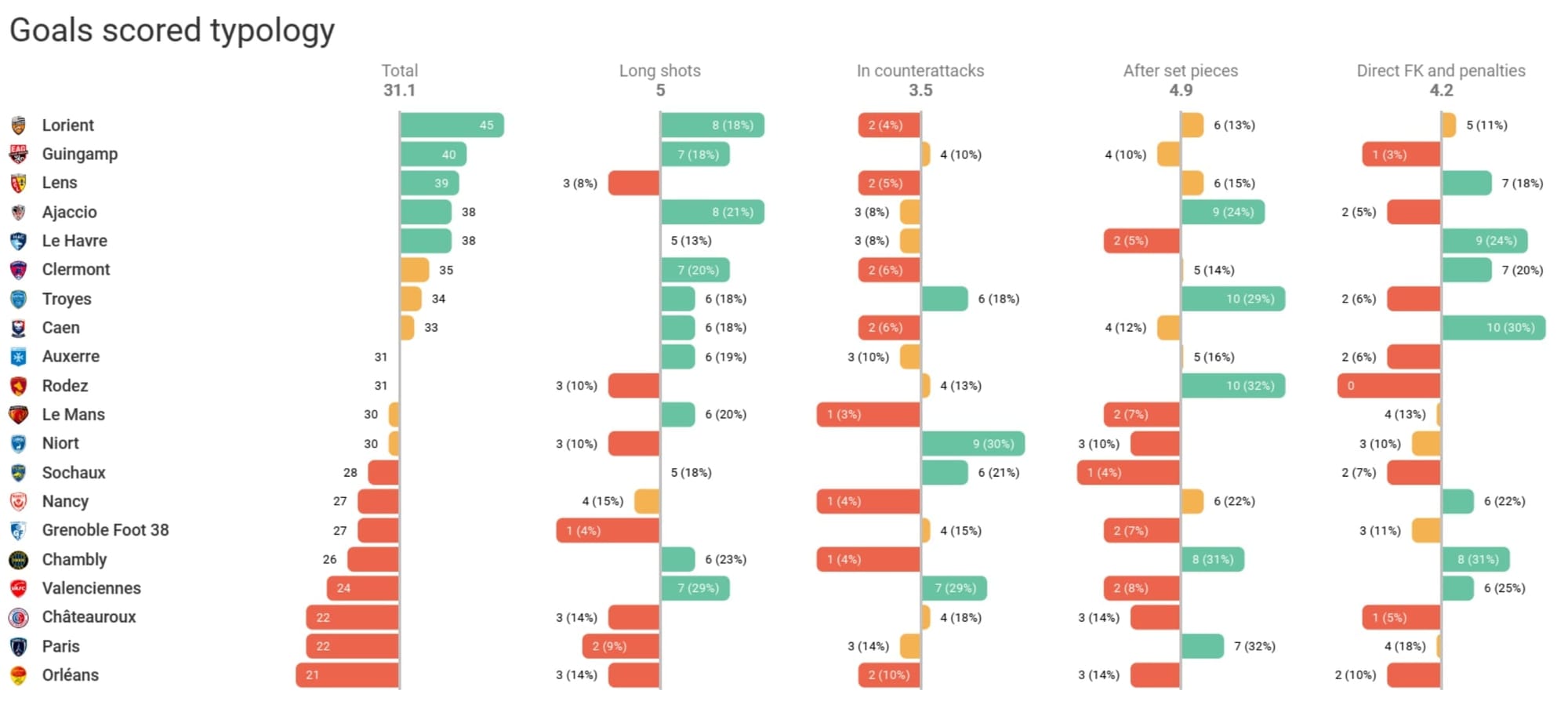
In the table above you can see the variety and tendency of each Ligue 2 team in regards to goalscoring. Chambly in total have scored 26 goals this season in Ligue 2 which is quite low compared against the league average which is 31.1. Luzi’s side aren’t really the type of team that would dominate a game. They are, however, quite patient in possession and look to build-up from the back and play out of pressure, rather than relying too much on counter-attacking. Being a mid/low-blocking team with a passive approach in defence, Chambly are usually pinned inside their own half. With 10 or even 11 men defending inside their own half, often it’s quite difficult to break quickly in counter-attack especially due to the lack of options upfront, lack of players with pace, and the sheer distance they have to cover to get to the opposing team’s goal, thus you can see the low amount of goals from counter-attack there. Their tactical tendencies and some of their numbers might be a bit similar to Premier League side Newcastle, but the two teams don’t seem to play with a similar style.
Despite the difference in volume and a huge difference in tactics and playing style, their goalscoring tendencies are a little similar to Lorient. Christophe Pélissier’s side finished top of the table this season and got a well-deserved promotion to Ligue 1. His team have scored the most goals this season and a large part of their goals were scored from positional plays. They’ve also scored a decent amount of goals from long shots with eight goals from outside the box as well as a decent amount of goals from direct and indirect set-pieces with a total of 11 goals.
Compared to Ligue 1 teams, Paris Saint-Germain actually show high effectiveness and efficiency from direct and indirect set-pieces as well although goals from set-pieces only make up about 21% of their total goal tally (16 goals from 75). Meanwhile, Bordeaux and Nice scored 35% (14 set-piece goals from 40 total) and 34% (14 set-piece goals from 41 total) of their respective goal tallies from set-pieces which are above average in Ligue 1 (9.3 goals from set-pieces on average). However, none of the aforementioned teams rely too much on set-pieces to score goals.
For Chambly, a lot of their goals from open play seem to be created from the wide areas and half-spaces. Usually, a wide player will look to cross the ball towards the big target man in the centre of the box, or an attacker in the far-post. Other times, the wide player would deliver a cutback cross towards a player at the edge of the box. Sometimes, a wide player would also try to cut inside and shift the ball to their strongest foot before taking a shot from inside or outside the box.
However, Chambly scored the majority of their goals from set-pieces – both direct and indirect. In total, they’ve scored over 50% of their goals this season from set-piece situations (free-kick, corner, throw-in, and penalties). This is why you shouldn’t be surprised upon seeing that their top scorers this season are set-piece specialist attacking midfielder Florian David with five goals (three of which came from direct free-kicks) and centre-back Thibault Jaques also with five goals (four from penalties and one goal from a header from a set-piece situation). Their corner and free-kick routines are quite interesting to look at and in the first part of this tactical analysis, we’ll focus mostly on the offensive corner routines.
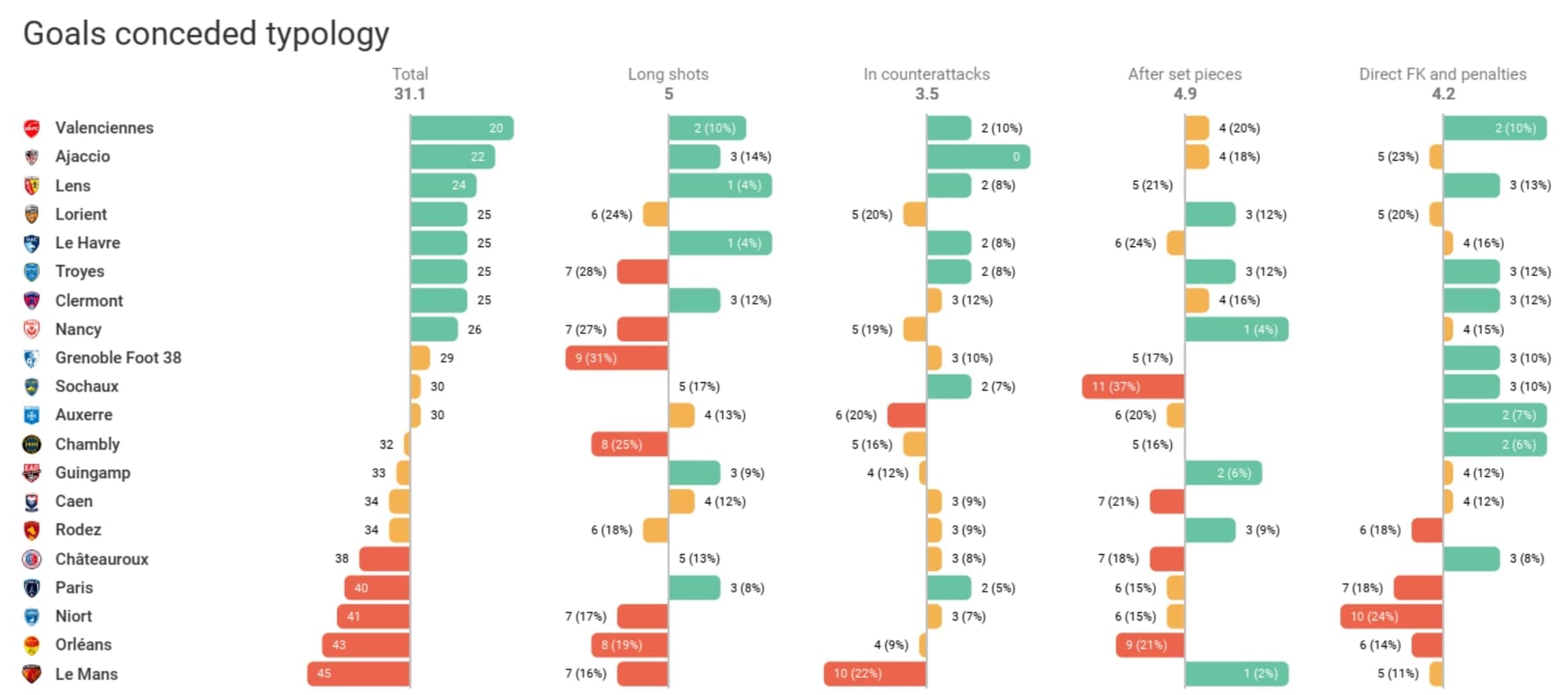
Looking at the next table, you can see the variety and tendency of each Ligue 2 team in regards to goals conceded. Chambly have conceded a total of 32 goals this season. As mentioned before, Chambly tend to sit back and absorb the opposing team’s pressure rather than pressing the opposing team into losing the ball. They tend to sit back and form a vertically compact mid/low-block. Their passiveness in defence can even be seen from their stats this season. Chambly are the lowest-ranked team when it comes to challenge intensity and the second-lowest when it comes to PPDA. Luzi’s side average only 5.1 defensive actions per minute of opponent possession and they allow about 13.93 PPDA on average per game. They are, however, good at preventing the opposing team from finding good positions inside their own half as well as creating high-quality chances. This is why they concede quite a lot from long-range shots.
Meanwhile, they concede less from set-pieces, both direct and indirect. As you can see in the table above, Chambly have conceded a total of seven goals out of 32 from direct and indirect set-pieces as well as penalties which makes only about 22% of their total goals conceded. Compared to the league average, their numbers are also relatively low.
Attacking corners
Chambly have garnered a total of 95 attacking corner opportunities throughout this season, which is the lowest number in the league. Not really surprising due to their lack of attacking thrust and their low number of attacking and goalscoring opportunities in general.
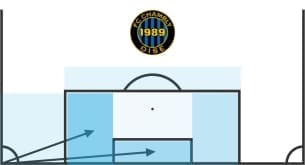
In the image above you can see their distribution tendency. Chambly seem to favour distribution towards the near post as well as the six-yard box. Meanwhile, short corners, as well as distributions towards the far-post or penalty area, are not as often seen compared to near-post and six-yard box although they can be seen occasionally throughout the season.
Looking at Chambly’s attacking corners this season, I can see that they’re actually pretty straightforward in their attacking corner. They’d mainly have six players inside the box in a regular corner situation. Usually, four or five of those players will get into position to attack the ball, while one or two will watch out for rebounds inside the box. There will also be one or two players sitting just outside the penalty area. However, the number of players may change depending on their mentality in a game. If they’re in a cautious/defensive mentality (usually when they’re leading), they’ll send fewer players into the box and will have more players behind or around the edge of the box for spill outs while when they’re trailing and looking to score a goal, then they’ll have more players upfield.
In terms of set-piece tactics, they don’t seem to have a lot of variations in their routines, although they may improvise in certain situations. Corner takers also don’t seem to give hand signs prior to taking the corner which may indicate that they don’t have any other particular routines they’re looking to execute other than the one that they usually use in a game.
In addition, the corner takers don’t seem to change, regardless whether it is from the right or left side. The main corner takers are Anthony Soubervie, Joris Correa, and Florian David, and all three are right-footed. This means that sometimes they may play outswinging corners, some other times inswinging. However, regardless of whether the delivery is inswinging or outswinging, again, there don’t seem to be any change of routine that can be seen; preparation and positioning inside and outside the box, running routes, as well as, delivery target are pretty much the same.
They have this very consistent tendency to create a grouping or sometimes a vertical line at the edge of a box in preparation for the corner. Again, regardless of their opponents’ tactics in defending corners, they still use the same routines.
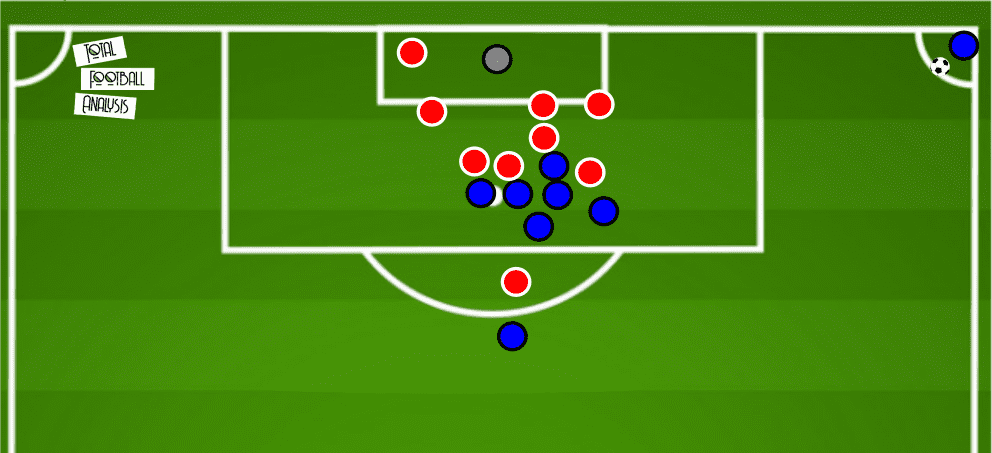
Above is an example of their positioning in preparation for the corner. In the particular situation above, Chambly are going against a team with a mixed approach but mostly man-oriented. You can see that Chambly players tend to sit a little further from the goal and near the penalty area. Some are even positioned near the edge of the box. As you can see above, there are six players inside the box while one player is outside the box and two others (not in frame) will sit back for rest defence.
The attackers (usually players with bigger frame and superior ability in the air) will aim to dash into their designated positions to attack the ball upon seeing the corner taker running up to strike the ball. Meanwhile, the smaller players will look to either: create blocking (to slow down the opponent and potentially create mismatches or separations), move to create distractions, or get into the rebound zone.
By creating a grouping in a particular area inside the box as in the image above, Chambly can make it difficult for the opposing team to man-mark their players. This is because aside from the traffic can really slow down the opponent from getting close to the man they’re supposed to mark, thus allowing the target to move freely. This is mainly what makes Chambly quite effective against teams with man-oriented defending when it comes to set-piece.
As mentioned above, upon seeing the run-up of the corner taker, players will quickly move to get into their positions which you can see in the illustration below.
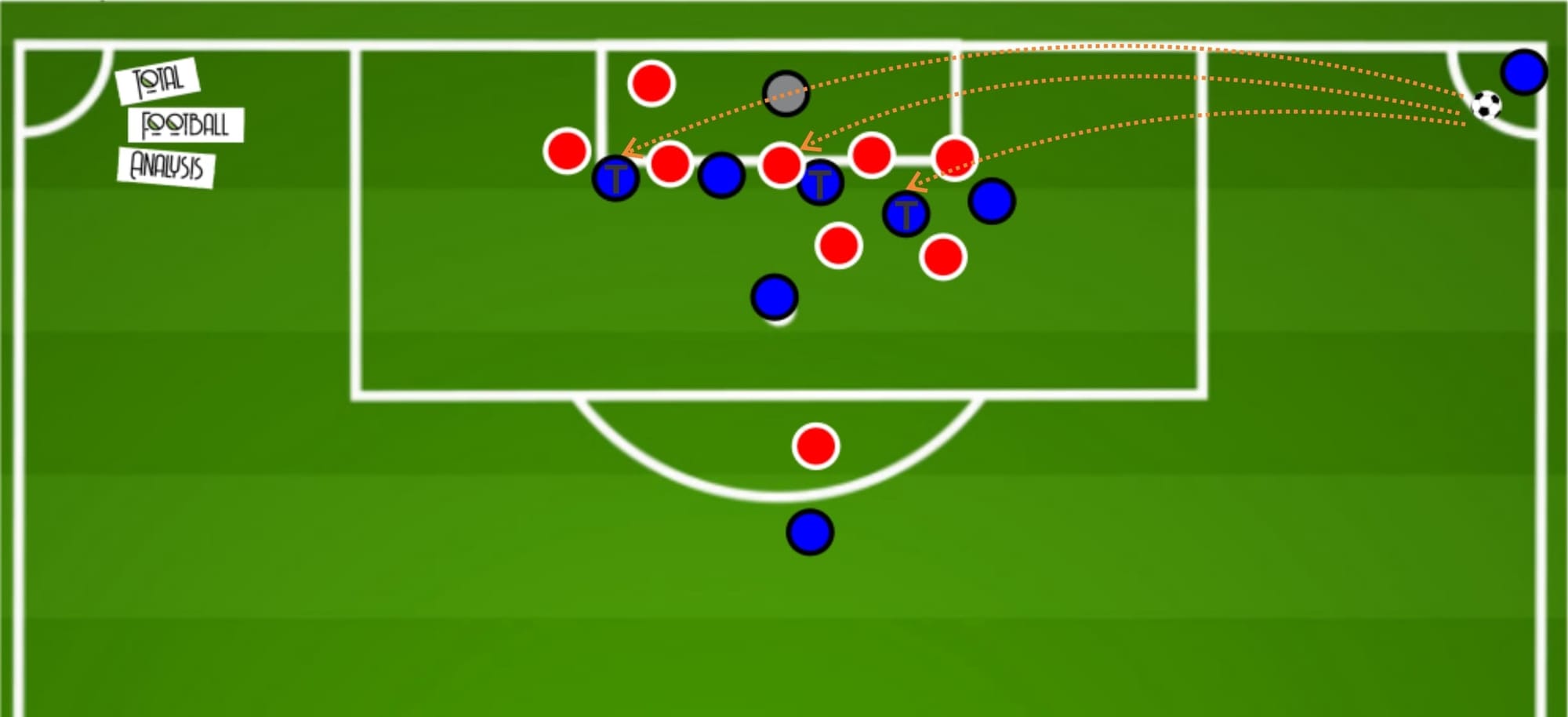
The players’ running routes are pretty simple and pretty much the same in virtually all the attacking corners they take this season. Players will spread evenly across the face of the goal. There would usually be three targets to hit (sometimes four). One in the near post, one in the centre, and the other one in the far-post. Players in the near and far-post can either shoot/head directly towards goal or lay the ball off for their teammate, meanwhile the player in the centre will usually shoot/head directly towards goal if he connects with the delivery.
Aside from that, you can see the other two attackers above that are not the main targets, but they still get into an attacking position to pretty much distract the opponents and potentially attack the rebound if a goalkeeper fails to save the first shot or catch the first ball properly. Aside from the five attackers in and around the six-yard box, there will be one player who will usually position himself in the rebound zone inside the box (near penalty spot) while the other one prepares if the ball falls outside the box.
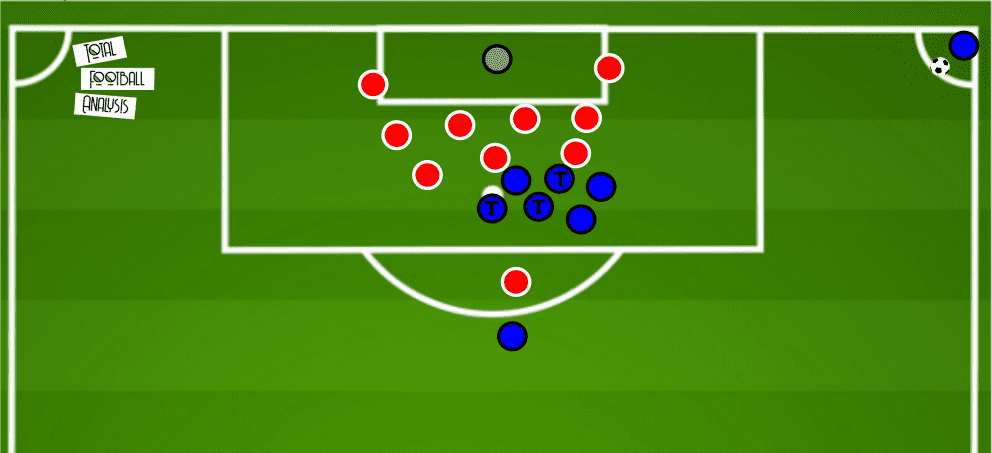
Pretty much the same running routes can be seen even when the opposing team employ zonal defence. Again, in the image above you can see that there would be a group of Chambly players in one area of the box who will then dash into position to attack the ball. Running routes are pretty much also the same with about four or five players spreading evenly across the opposing team’s goal and one or two preparing for rebound inside the box and usually just one preparing for rebound outside the box.
Looking at their attacking corners, there are a few strategies that they employ very often. Creating traffic as well as making opposite movements and fake runs are very common. These tactics allow them to create separations or even dismarkings inside the box. As mentioned before, blocking can also potentially slow down an opponent and create mismatches. By slowing down the opponent, the corner target can get into position and prepare to connect with the delivery more comfortably. Meanwhile, mismatches mean that the corner target is usually still picked up and marked, but not by the supposed marker – which means that they may be picked up by a smaller opponent which can give them advantage in the box.
Moving on, talking about targets inside the box, Chambly will look to maximise their opportunity inside the box by having the bigger players occupying the box and being the main targets, while, as mentioned earlier, smaller players inside the box may look to create blocking, make distractions, or get into rebound zone. Players outside of the box are usually also smaller players.
The targets that will attack the ball are usually the tall target man (mainly Lassana Doucouré and/or Medhy Guezoui) and centre-backs/defensive midfielders (mainly Thibault Jaques, Oumar Gonzalez, Maxence Derrien, Romain Padovani and Guillaume Dequaire). Sometimes, Chambly will have all three centre-backs going into the box in attacking corners, some other times, only two. Delivery target may vary though. Chambly don’t seem to focus mainly on getting the ball towards a specific man but mainly on getting the ball towards a specific zone. Again, as mentioned earlier, mostly they deliver towards the near post or centre, but sometimes also towards the far-post. With target players spreading across the goal evenly, the deliverer has options in multiple zones.
However, unlike against opposing teams with man-oriented set-piece defence, Chambly seem to be a bit struggling against teams with zonal-oriented defence. An opposing team with zonal-oriented defence usually have their players occupying predetermined positions and those players are unlikely to get dragged out and move out of position. Chambly’s tendency to create traffic as well as making double or false movements are not very effective against these teams. Furthermore, they lack variation in their attacking corner routine and will still use pretty much the same strategy regardless of the opposing team’s setup. However, this doesn’t necessarily mean that they’re unable to score against zonal-oriented teams.
Looking at their goal tally from corners, three of them have come against teams with man-oriented set-piece defence, while two of them have come against teams with zonal defence. It seems that Chambly tend to be able to win more of the first balls against man-oriented sides but they’re quite proficient in collecting rebounds/second balls and then creating another chance in attack against zonal-oriented teams.
There are a few other variations to their attacking corner routine that can occasionally be seen throughout the season albeit not very often.
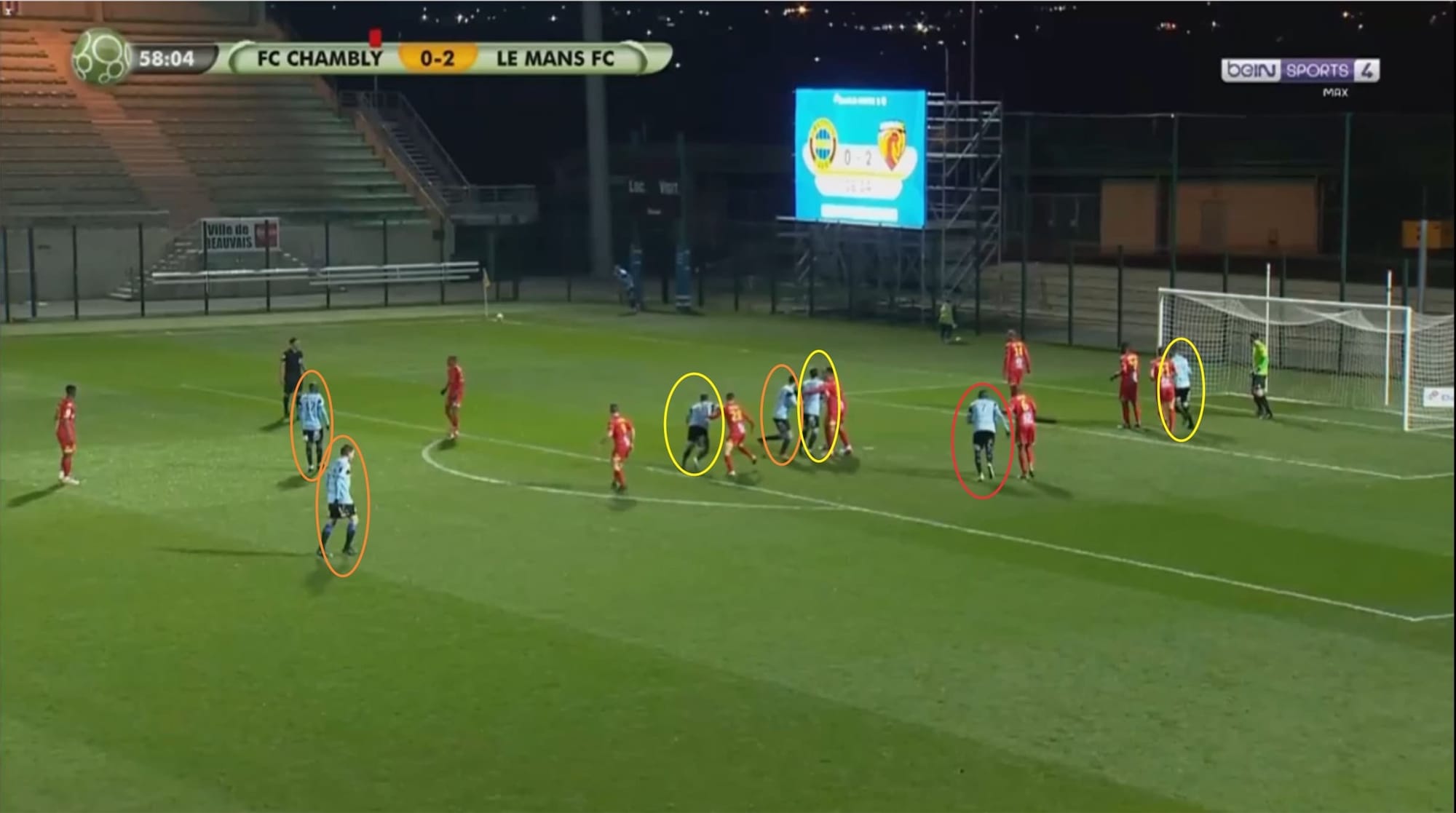
The first one is creating an overload in one side of the box and exploiting the underloaded area. Above you can see Chambly won a corner against Le Mans, who employ a mix of man and zonal marking. At the start, Chambly created a line of three players at the edge of the box in order to make it difficult for Le Mans to man-mark their players.
In this particular situation, they’re looking to deliver the ball towards the far post. The three players in the yellow circles will be the distraction in this routine while the three players in orange circles will prepare for a rebound (one inside the box and two right outside the box). Meanwhile, the player in the red circle will be the main target.
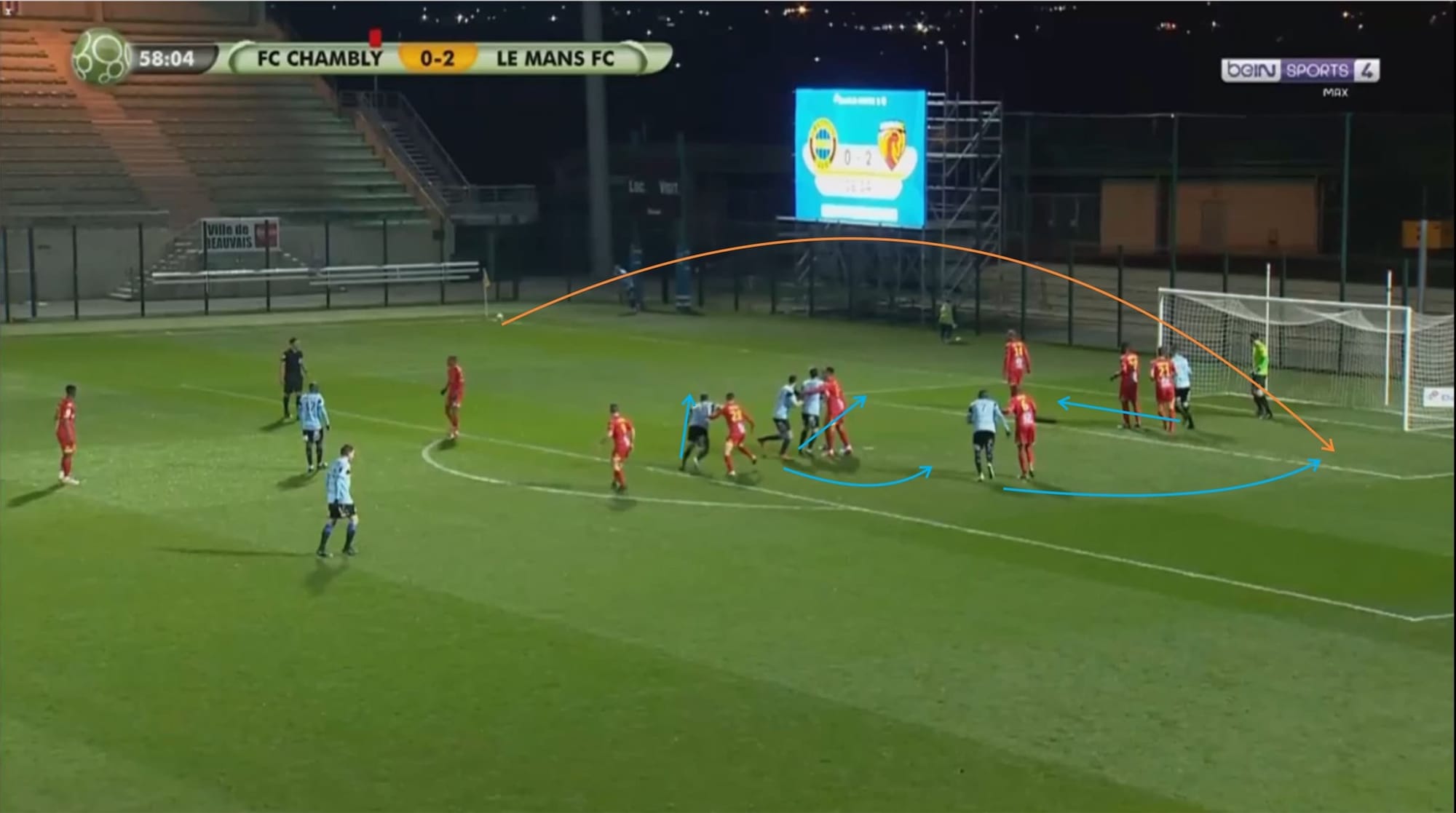
In the image above, we can see the movements that the players will make when the corner taker runs up. You can see that there are three players that will move towards the near-post, thus effectively freeing up the far-post from any opponent. Meanwhile, one player will move towards the central area inside the box for rebound and the main target man moves towards the far-post. Again, as mentioned previously, fake movements and blockings are used in this situation and are quite effective. Doucouré, who’s the main target, makes a double movement by moving towards the near post first before quickly changing directions towards the far-post in order to dismark himself from his marker.
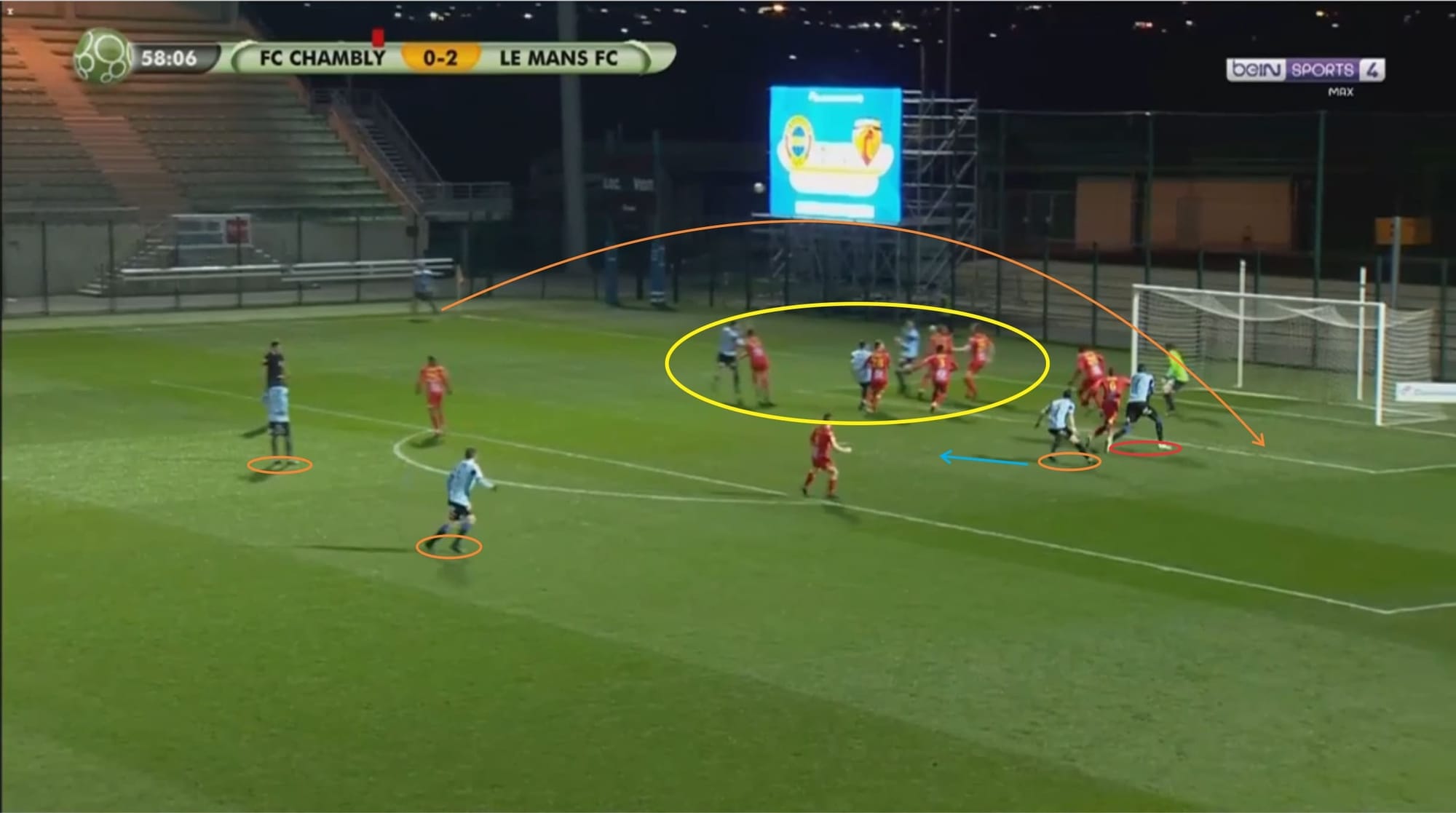
Above you can see that Chambly successfully created an overload in the near-post area and freed up the far-post area for Doucouré to attack. This routine is a little bit different than their usual routine, as usually they will have players spread evenly across the six-yard box, and there would usually be no specific targets (albeit their tendency to deliver more often towards the near-post and central area).
Some other times, Chambly may try to use a short corner routine.
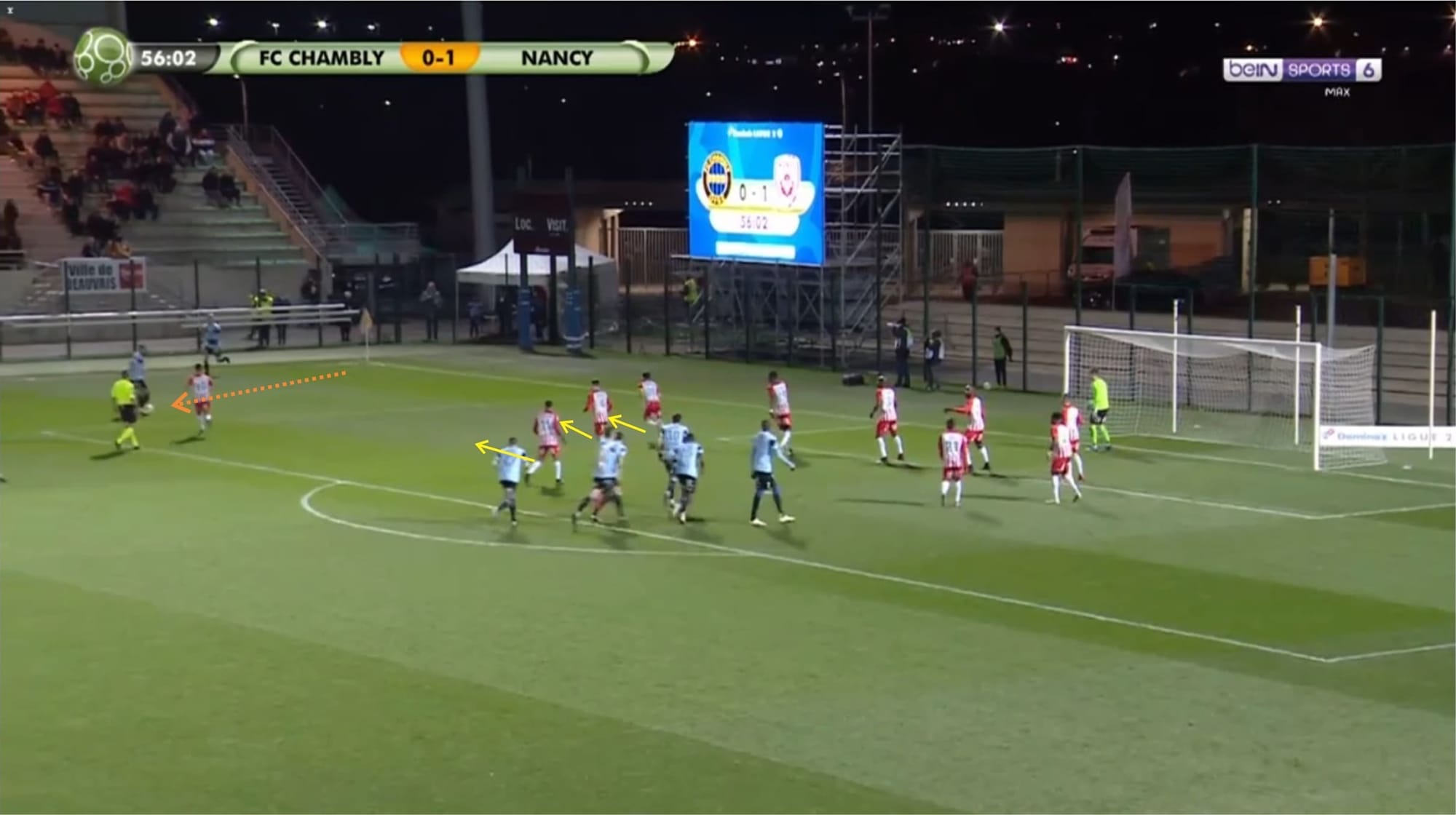
Short corner routines are usually good against teams with zonal defence in set-piece as this can disrupt their zonal structure by attracting player out of their predetermined position. Above, Chambly were in a match against Nancy ,who tended to defend with zonal orientation. Chambly’s set-up is pretty much the same as usual. Players would form a grouping to create traffic and would start from deep before dashing into position rather than positioning themselves closer to the goal.
The only difference was that there would be a player coming close to the corner taker and would receive the ball on the flank. The player might or might not delay crossing after receiving the ball depending on the situation. In this particular situation, the ball receiver delayed to cross and waited until Nancy players moved further out of position. Fortunately, the rest of Nancy defenders stayed deep and played Chambly’s attackers onside. However, the cross from the flank was not accurate in this case and Chambly failed to take advantage from it.
Final remarks
The analysis above mainly gives a bit of an overview of Chambly’s style of play and dependency on set-pieces this season as well as a slight peek of their attacking corner routines. This would be the first part of Chambly’s set-piece analysis. In the second part, we’ll take an in-depth look at how Chambly set-up their attacking free-kick routines as well as defensive free-kicks and corners.

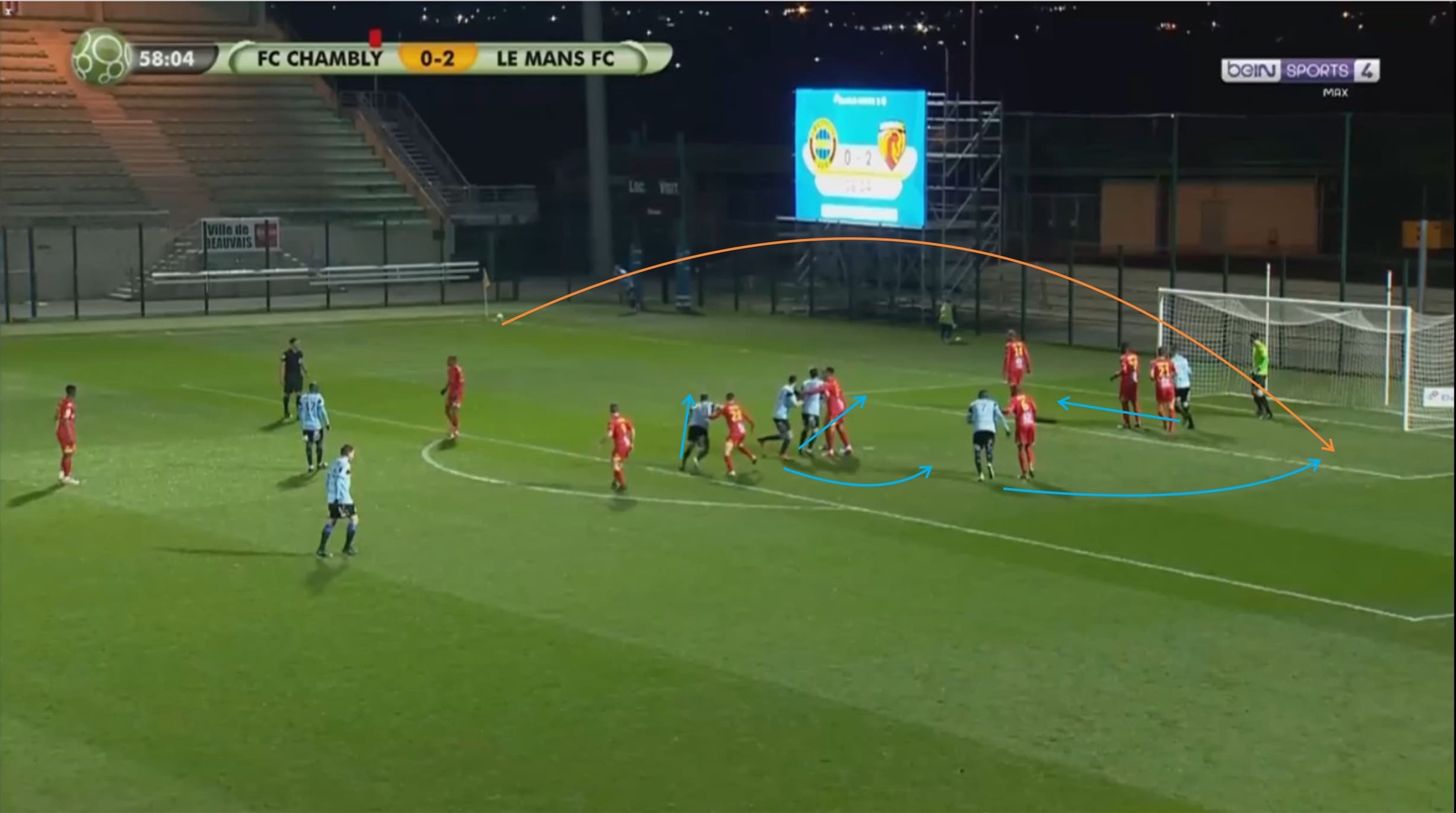



Comments